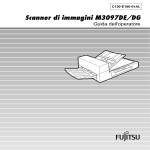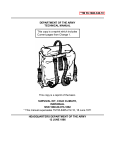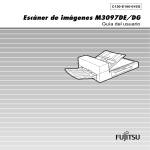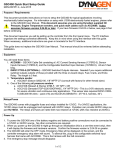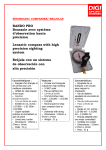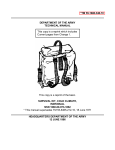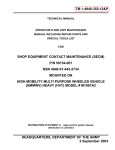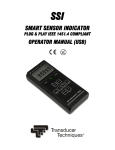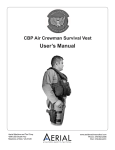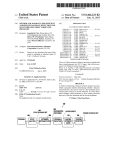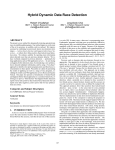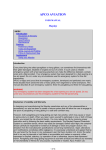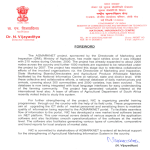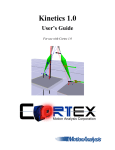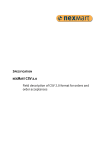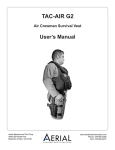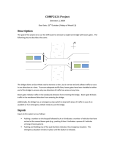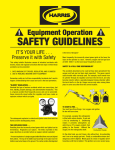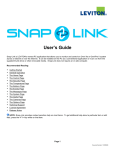Download TM 1-1680-359-10 22 MAY 1992
Transcript
TM 1-1680-359-10 OPERATORS MANUAL AIRCREW SURVIVAL ARMOR RECOVERY VEST, INSERT, AND PACKETS (SARVIP) DISTRIBUTION STATEMENT A Approved for public release distribution is unlimited HEADQUARTERS DEPARTMENT OF THE ARMY 22 MAY 1992 TM 1-1680-359-10 WARNING FLIGHT OPERATIONS WHILE WEARING SARVIP Prior to flight operations in any aircraft, aviators/aircrew members must ensure that the SARVIP vest and ballistic insert do not cause interference with flight controls, weapons systems operation, or restrict performance of in flight duties. WARNING RESTRAINT HARNESS The SARVIP vest is not designed to be used in lieu of the gunner/hoist operator restraint harness. Use of SARVIP only will not provide restraint to the aircraft. Don the restraint harness over the SARVIP vest and ensure security of harness tether during flight operations. WARNING ARMOR INSERT Ensure carrier's closure flap is securely fastened. The armor insert is heavy and could injure legs and feet if inadvertently dropped. a TM 1-1680-359-10 WARNING LIFT PREPARATION Ensure vest slide fastener is engaged and fully closed and waist and chest adjustment straps are properly fastened to provide a snug fit prior to personnel lift operation. WARNING SMOKE AND ILLUMINATION SIGNAL Don't light both ends of a signal at the same time. Be careful when using the illumination signal, as drippings from the burning signal can cause serious burns on the body. WARNING TRIOXAME COMPRESSED FUEL Fuel contains metaformaldehyde, which is highly toxic. Don't put hands near mouth or eyes after handling opened or leaking packages. Wash hands immediately. For first aid procedures, refer to FM 21-11. b TM 1-1680-359-10 TECHNICAL MANUAL No. HEADQUARTERS DEPARTMENT OF THE ARMY Washington, D C., 22 May 1992 1-1680-359-10 Operator's Manual AIRCREW SURVIVAL ARMOR RECOVERY VEST, INSERT, AND PACKETS REPORTING ERRORS AND RECOMMENDING IMPROVEMENTS You can help improve this manual If you find any mistakes or if you know of a way to improve the procedures, please let us know Mall your letter or DA Form 2028 (Recommended Changes to Publications and Blank Forms), direct to Commander, U S Army Aviation Systems Command, ATTN AMSAV-MC, 4300 Goodfellow Boulevard, St Louis, MO 63120-1798 A reply will be furnished to you. TABLE OF CONTENTS CHAPTER 1 Section I Section II Page INTRODUCTION General Information ................................................. 1-1 Equipment Description............................................. 1-2 DISTRIBUTION STATEMENT A: Approved for public release; distribution is unlimited. i TM 1-1680-359-10 TABLE OF CONTENTS (Cont) Page CHAPTER 2 OPERATING INSTRUCTIONS Section I Description and Use of Operator's Controls s and Indicators. ................................................... 2-1 Section II Preventive Maintenance Checks and Services (PMCS) ............................................................. 2-9 Section III Operation Under Usual Conditions ......................................................... 2-19 Section IV Operation Under Unusual Conditions ......................................................... 2-48 CHAPTER 3 MAINTENANCE INSTRUCTIONS.................................. 3-1 APPENDIX A REFERENCES .............................................................. A-1 INDEX....................................................................................................................................................... I-1 ii TM 1-1680-359-10 CHAPTER 1 INTRODUCTION Section I. GENERAL INFORMATION 1-1. SCOPE. This manual is for your use when, as an air-crew member, you are required to use the Aircrew Survival Armor Recovery Vest, Insert, and Packets (SARVIP). The purpose of this manual is to provide you with a description of the components and instructions on their intended use and care. 1-2. MAINTENANCE FORMS AND PROCEDURES. Department of the Army forms and procedures used for equipment maintenance will be those prescribed by DA Pam 738-751, Functional User's Manual for the Army Maintenance Management System Aviation (TAMMS-A). 1-3. REPORTING EQUIPMENT IMPROVEMENT RECOMMENDATIONS (EIR'S). If your SARVIP needs improvement, let us know. Send us an EIR. You, the user, are the only one who can tell us whale you don't like about your equipment. Let us know why you don't like the design or performance. Put it on an SF 368 (Product Quality Deficiency Report). Mail It to us at. Commander, U S Army Aviation Systems Command, ATTN AMSAV-QRF, 4300 Goodfellow Boulevard, St Louis MO 63120-1798. We will send you a reply. 1-1 TM 1-1680-359-10 1-4. DESTRUCTION OF ARMY NATERIEL TO PREVENT ENEMY USE. Procedures for destroying Army materiel to prevent enemy use are listed in TM 750-244-3. Section II. EQUIPMENT DESCRIPTION 1-5. EQUIPMENT CHARACTERISTICS, CAPABILITIES, AND FEATURES. The Aircrew Survival Armor Recovery Vest, Insert, and Packets (SARVIP) is a three part system: survival vest, armor insert with carrier, and survival, signal and communication components. Vest. The vest Is fabricated from raschel knit and fire resistant aramid oxford fabrics. It contains a total of twelve pockets; ten outer and two inner. Together these pockets house all survival, signal and communication components. For rescue-lift, a nylon webbing harness system is permanently attached to the vest in a cradle fashion and contains both leg and chest straps. The chest strap also provides the means for attaching the LPU/10 life preservers. The vest also provides means for attaching a motor housing and face mask carrier when wearing MOPP clothing. Insert. The armor insert consists of a laminated ceramic/fiberglass composite backed with a 3/4 inch thick foam padding. The foam padding provides blunt trauma protection when 1-2 TM 1-1680-359-10 1-5. EQUIPMENT CHARACTERISTICS, CAPABILITIES, AND FEATURES (Cont) struck with small arms fire. A fire resistant aramid oxford fabric carrier with seven layers of Kevlar (R) is provided to carry the insert. The Kevlar (R) provides the necessary spall protection from the insert when the insert is impacted with a round. A cradle type harness arrangement on the carrier is used for holding the insert on the body. A quick release strap located on the bottom of the carrier allows the insert to be jettisoned during emergencies. Survival Signal and Communication Components. Placed in the various pockets on the vest are the following items: compass, mirror, smoke and Illumination flares, sea dye marker, distress light marker, chemical agent detectors, distress signal kit, operators manual, and survival packets consisting of medical and basic components necessary for survival. A pocket is also provided on the vest for carrying a PRC-90 or PRC-112 radio. Operation of the AN/PRC-90 or AN/PRC-112 will span a wide range of weather extremes. Although the radio circuits are operable over a temperature range of -30°to +500C (-22°to +1220F), the battery power supply is only effectively operable over a 0°to +54°C (+32° to +1290F) temperature range. Operating at low temperature reduces battery life. The radio may be stored over a temperature range of -60°to +60°C (-76°to +1400F). 1-3 TM 1-1680-359-10 1-6. LOCATION AND DESCRIPTION OF MAJOR COMPONENTS Item 1 2 Description BODY ARMOR INSERT. A ceramic/ fiberglass armor insert with foam padding providing ballistic and blunt trauma protection from small arms fire up to 12.7 MM (.50 CAL). BODY ARMOR INSERT CARRIER. Aramid oxford fabric carrier with seven layers of Kevlar (R) used to carry armor insert. 1-4 TM 1-1680-359-10 1-6. LOCATION AND DESCRIPTION OF MAJOR COMPONENTS (Cont) Item Description 3 TYPEI(BASIC)SURVIVAL PACKET.A sealed polyethylene bag containing basic items necessary for survival. 4 LENSATIC COMPASS. Used to determine the direction of travel. 5 VEST. Raschel knit and oxford fire resistant fabric that contains survival components. 6 EMERGENCY SIGNALING MIRROR. Used to signal aircraft or other targets. 7 TYPE II (MEDICAL) SURVIVAL PACKET.A sealed polyethylene bag containing medical items necessary for survival. 8 DISTRESS MARKER LIGHT. Produces intermittent flash of light visible for minimum of 5 miles. 9 SEA DYE MARKER. Fluorescein dye for location in water. 10 OPERATOR'S MANUAL. Provides instruction for use and maintenance of vest and components. 1-5 TM 1-1680-359-10 1-6. LOCATION AND DESCRIPTION OF MAJOR COMPONENTS (Cont) 1-6 TM 1-1680-359-10 1-6. LOCATION AND DESCRIPTION OF MAJOR COMPONENTS (Cont) Item Description 11 FOLIAGE PENETRATING SIGNAL KIT. Consists of a rocket launcher and seven red flares. 12 CHEMICAL DETECTOR PAPER. Used to detect presence of nuclear, biological, or chemical agents. 13 TYPE IV SURVIVAL PACKET. A sealed polyethylene bag containing a combat casualty blanket. 14 TYPE III SURVIVAL PACKET. A sealed polyethylene bag containing a first aid dressing and water storage bag. 15 AN/PRC-90 OR AN/PRC-112 RADIO. Used to transmit and receive radio messages. 16 MK-24 SMOKE AND ILLUMINATION FLARES. Daytime or nighttime signal for rescue. 17 LPU-10/P LIFE PRESERVERS. Inflatable life preservers. 1-7 TM 1-1680-359-10 1-7. DIFFERENCES BETWEEN MODELS. There are no component or capability differences between the various sized models. 1-8. EQUIPMENT DATA. a Armor Insert. Length (inches) Short Medium Long X-Long 9.8 11.1 12.5 12.9 Top Width (inches) Bottom Width (inches) Weight (pounds) 8.6 9.4 9.2 10.1 11.5 12.5 12.8 12.9 9.2 10.9 13.5 13.9 b. Vest Chest (inches) X-Small Small Medium Large X-Large Under 33 33 - 37 37 - 41 41 - 45 Over 45 Waist (inches) Under 27 27 - 31 31 - 35 35 - 39 Over 39 1-8 TM 1-1680-359-10 CHAPTER 2 OPERATING INSTRUCTIONS Section I. DESCRIPTION AND USE OF OPERATOR'S CONTROLS AND INDICATORS 2-1. CONTROLS AND INDICATORS. The only controls and indicators are on the radio set, AN/PRC-90. Control or Key Indicator 1 Function Switch (fourposition rotary switch) Function Selects transceiver operating mode and turns radio off. 2-1 TM 1-1680-359-10 2-1. CONTROLS AND INDICATORS (Cont) Control or Key Indicator Function 1 Function Switch (Cont) Switch Position: OFF Removes power from radio set. VOICE 282.8 Turns receiver on for reception of 282.8 MHz voice signals and permits 282.8 MHz voice transmission when PUSH TO TALK button is pressed. (Function switch button must be pressed to place switch in this position.) 2-2 TM 1-1680-359-10 2-1. CONTROLS AND INDICATORS (Cont) Control or Key Indicator 1 Function Function Switch (Cont) BCN 243.0 Turns on 243.0 MHz transmitter and transmits a beacon tone. Swept audio tone is continuously transmitted for rescue aircraft to home on. Voice reception and transmission cannot be used in this mode. VOICE/MCW Turns receiver on for reception of 243.0 MHz voice or MCW signals. Also permits 243.0 MHz voice or MCW transmission when keyed by PUSH TO TALK or MCW buttons. 2-3 TM 1-1680-359-10 2-1. CONTROLS AND INDICATORS (Cont) Control or Key Indicator 2 Function Switch Arrow/ PUSH TO TALK Pushbutton Function Indicates operational mode selected and locks out VOICE 282.8 position unless pressed. When it is pressed, it turns receiver off and turns transmitter on when function switch is in either VOICE/MCW 243.0 or VOICE 282.8 position. Best voice transmission is obtained when spoken directly into the TALK microphone. When the button is released, it turns off the transmitter and turns on the receiver; received signal is heard from the LISTEN speaker or earphone. 2-4 TM 1-1680-359-10 2-1. CONTROLS AND INDICATORS (Cont) Key 3 Control or Indicator MCW Button Function Can be used as a telegraph key to transmit morse code when normal voice transmission may reveal operator's position. MCW is only available when function switch is in the VOICE/MCW 243.0 position. When MCW button is pressed, radio set transmits continuous tone and receiver is off. When button is released, transmitter is turned off and receiver is turned on. 2-5 TM 1-1680-359-10 2-1. CONTROLS AND INDICATORS (Cont) 2-6 TM 1-1680-359-10 2-1. CONTROLS AND INDICATORS (Cont) Key Control or Indicator Function 4 VOL Control Controls sound level from LISTEN speaker or earphone. Controls received signals, not sidetone. When control is in MAX position, greatest level of sound is heard; when fully turned down, lowest level of sound is heard, but radio set is not turned off. Control setting does not affect transmitter output. 5 Antenna Receptacle Provides connection for radio set antenna. 6 EARPHONE JACK Provides connection for ear phone. When earphone is connected, LISTEN speaker is shut off and sound is heard from earphone. 7 LISTEN Speaker Projects sound of received signal; sound of MCW or beacon transmitter (sidetone) may also be projected. LISTEN speaker is shut off when earphone is connected. 2-7 TM 1-1680-359-10 2-1. CONTROLS AND INDICATORS (Cont) Control or Key Indicator Function 8 TALK Microphone Picks up voice being transmitted when PUSH TO TALK button is pressed and function switch is set to VOICE/MCW 243.0 or VOICE 282.8 position. 9 Battery Cap Holds battery in place and externally seals battery compartment. 2-8 TM 1-1680-359-10 Section II. PREVENTIVE MAINTENANCE CHECKS AND SERVICES (PMCS) 2-2. INTRODUCTION a. General. Table 2-1 (PMCS Table) has been provided so you can keep your equipment in good operating condition and ready for its primary mission. b. Warnings and Cautions. Always observe the WARNINGS and CAUTIONS appearing in your PMCS table. WARNINGS and cautions appear before applicable procedures. You must observe these WARNINGS and CAUTIONS to prevent serious injury to yourself and others or prevent your equipment from being damaged. c. Explanation of Table Entries. (1) Item number column. Numbers in this column are for reference. When completing DA Form 2404 (Equipment Inspection and Maintenance Worksheet), include the item number for the check/service indicating a fault. (2) Interval column. This column tells you when you must do the procedure in the procedure column. BEFORE procedures must be done before you operate or use the equipment for its intended mission. AFTER procedures must be done immediately after you have operated or used the equipment. 2-9 TM 1-1680-359-10 2-2. INTRODUCTION (Cont) (3) Location, check/service column. serviced. The item location is underlined. This column provides the location and the item to be checked or (4) Procedure column. This column gives the procedure you must do to check or service the item listed in the Check/Service column to know if the equipment is ready or available for its intended mission or for operation. You must do the procedure at the time stated in the interval column. (5) Not fully mission capable if: column. Information in this column tells you what faults will keep your equipment from being capable of performing its primary mission. If you make check and service procedures that show faults listed in this column, do not operate the equipment. Follow standard operating procedures for maintaining the equipment or reporting equipment failure. d. Other table entries. Be sure to observe all special information and notes that appear in your table. 2-3. SPECIAL INSTRUCTIONS. a. The sealed packets are exempt from opening for inspection. The packets are sealed in a NBC protective film with air evacuated. 2-10 TM 1-1680-359-10 2-3. SPECIAL INSTRUCTIONS (Cont) The components within have been individually sealed in a plastic material. Each packet contains an inventory list of components for use when the packet is opened. b. The medical packet has a separate inventory list of medical components that have a potency expiration. This list contains the nomenclature, manufacturer, date of manufacture, and expiration date. 2-11 TM 1-1680-359-10 Table 2-1. Preventive Maintenance Checks and Services for SARVIP Item No. Interval Location Item to Check/ Service Procedure Not Fully Mission Capable if: NOTE PMCS Item numbers correspond to figure numbers on page 1-4. 1 Before and After Body Armor Insert Check insert for chips or other damage. Insert damaged. 2 Before and After Armor Insert Carrier Check for dirt or foreign material, tears, loose or broken stitching; defective adj properly. straps, quick release strap or closure flap; broken or cracked side-release buckles. Carrier severely torn or flap torn or not functioning 2-12 TM 1-1680-359-10 Table 2-1. Preventive Maintenance Checks and Services for SARVIP Item No. Interval Location Item to Check/ Service Procedure Not Fully Mission Capable if: NOTE PMCS Item numbers correspond to figure numbers on pages 1-4 and 1-6. 3, 7, 13, 14 Before and After Packets Check for cuts, tears, water exposure, packets not sealed, missing bro ken or leaks, dates of medical items. Seals broken or items missing or items broken or leaking or medical items expired. 4 Before and After Lensatic Compass Check for broken or cracked dial face cover, operation, and original stowed position. Dial face cover broken or cracked or compass not operable. 2-13 TM 1-1680-359-10 Table 2-1. Preventive Maintenance Checks and Services for SARVIP Item No. Interval Location Item to Check/ Service Procedure Not Fully Mission Capable if: NOTE PMCS Item numbers correspond to figure numbers on page 1-4. 5 Before and After Vest Check for cuts, tears, holes, burns, broken or loose stitching/ hardware/ straps/tape, defective fasteners or snaplink carabiner. Vest severely torn, any damage to rescuelift harness and/or components. 6 Before and After Emergency Signalling Mirror Check for distortion, chips, cracks or scratches, unreadable Instructions, broken/missing lanyard. Mirror broken. 2-14 TM 1-1680-359-10 Table 2-1. Preventive Maintenance Checks and Services (Cont’d) Item No. Interval Location Item to Check/ Service Procedure Not Fully Mission Capable if: NOTE PMCS Item numbers correspond to figure numbers on page 1-4. 8 Before and After Distress Marker Light and Flashguard Check for broken/cracked light lens or flashguard, light operation. Light does not operate or broken flashguard. 9 Before and After Sea Dye Marker Check for cuts or holes or tears in packet, broken/missing retainer tape, packet opening tape not sealed completely, instruction markings illegible. Packet torn or marker leaking. 2-15 TM 1-1680-359-10 Table 2-1. Preventive Maintenance Checks and Services for SARVIP Item No. Interval Location Item to Check/ Service Procedure Not Fully Mission Capable if: NOTE PMCS Item numbers correspond to figure numbers on pages 1-4 and 1-6. 10 Before and After Operator Manual Check for torn or missing or illegible pages, dampness. Pages missing or illegible. 11 Before and After Foliage Penetrating Signaling Kit Check for damage, rust, dirt, corrosion, or other foreign material, operation of trigger screw, damaged/missing retainer cord, damaged or corroded or leaking flares. Severely damaged, leaking flares. 2-16 TM 1-1680-359-10 Table 2-1. Preventive Maintenance Checks and Services for SARVIP Item No. Interval Location Item to Check/ Service Procedure Not Fully Mission Capable if: NOTE PMCS Item numbers correspond to figure numbers on page 1-6. 12 Before and After Chemical Detector Paper Check for cuts or holes or tears in packet, instruction markings, packet expiration date. Pack torn, illegible instructions, or expired contents. 15 Before and After AN/PRC90 or AN/PRC112 Radio Check for damage, perforated seals, presence of salt/oil/sand accumulation, condition of earphone and case, and set operation. Structure severely damaged or set does not operate 2-17 TM 1-1680-359-10 Table 2-1. Preventive Maintenance Checks and Services for SARVIP Item No. Interval Location Item to Check/ Service Procedure Not Fully Mission Capable if: NOTE PMCS Item numbers correspond to figure numbers on page 1-6. 16 Before and After MK-24 Smoke and Illumination Flare Check for damage, severe dents, deformity, broken seals. Seals broken. 17 Before and After LPU-10/P Life Preserver Check for cuts or tears or abrasions, torn stitches or other damage to containers, safety tie on release pins, stains, dirt and general cleanliness. Containers damaged. 2-18 TM 1-1680-359-10 Section III. OPERATION UNDER USUAL CONDITIONS 2-4. GENERAL. This section provides instructions for wear and use of the SARVIP under normal operating conditions. 2-5. ASSEMBLY AND PREPARATION FOR USE a. Fitting Armor. To ensure the proper armor insert is selected, individuals must do the following. (1) Sit erect as shown; adjust feet to ensure that upper thighs are on a horizontal plane. (2) With upper arms hangingrelaxed, extend forearms and hands forward horizontally. (3) Place a 4-inch block of wood across your lap so that it is close to the body and in a horizontal position. 2-19 TM 1-1680-359-10 2-5. ASSEMBLY AND PREPARATION FOR USE (Cont) (4) Select an armor insert that, when placed vertical on the block of wood, the top of the insert is approximately 1 inch below the suprasternale location. (The suprasternale is the small indenture above the sternum.) An insert which comes closest to 1 inch below the suprasternale location is your correct insert size. b. Fitting Vest. (1) Put on required flight, MOPP and/or cold weather garments. (2) Select a vest based on your measurements (refer to paragraph 1-8 for vest sizes available). c. Attaching LPU-1O/P Life Preservers. The illustration below shows proper placement of LPU. 2-20 TM 1-1680-359-10 2-5. ASSEMBLY AND PREPARATION FOR USE (Cont) (1) Open vest and lay flat (outside exposed). (2) Extract chest strap from right pocket tunnel and three retaining loops on rear of vest. (3) Insert strap through retaining loops of LPU-10/P (ensure LPU-10/P is face up with inflation lanyard facing down) and through three retaining loops on rear of vest. (4) Insert strap through retaining loops of second LPU-10/P (ensure LPLI-10/P is face up with inflation lanyard facing down) and through pocket tunnel on right side of vest. d. Putting On Armor. For maximum comfort and protection, the body armor must be properly adjusted. The insert must be worn straight and centered on the front of the chest. Twisted or off center armor affects body balance and interferes with activities. For proper balance, the shoulder straps must be adjusted evenly. Armor should be snug but not too tight, as overtightening may inhibit the armor insert quick-release capability. 2-21 TM 1-1680-359-10 2-5. ASSEMBLY AND PREPARATION FOR USE (Cont) WARNING After inserting body armor, ensure carrier's closure flap is securely fastened. The armor insert is heavy and could injure legs and feet if inadvertently released from carrier. (1) Insert armor into carrier and fasten carrier's closure flap securely. (2) Engage adjustment strap buckles (located at bottom sides of carrier) and open carrier adjustment straps to maximum length. (3) Insert head and arms through loops formed by adjustment straps and carrier. (4) Raise and support armor to rest on chest with top of armor approximately 1 inch below suprasternale. (5) Pull left and right adjustment strap tabs until armor is adjusted (slightly taut) to chest. (6) Secure ends of adjustment straps with attached keepers. 2-22 TM 1-1680-359-10 2-5. ASSEMBLY AND PREPARATION FOR USE (Cont) e. Putting On Vest. (1) Unfasten vest's waist sizing strap at rear and don vest. (2) Engage and fully close slide fastener. NOTE Waist adjustment strap should be snug but not too tight. Overtightening may prohibit quick release of the armor insert. (3) Fasten and adjust waist adjustment straps at rear of vest. (4) Fasten and adjust the chest strap until snug: return excess strap through right pocket tunnel and fasten with attached keeper. (5) Attach snap-link carbine through the rescue-lift loops located on both sides of vest near top of slide fastener. (6) Check for proper fit/adjustment of armor and vest by bending, stooping, and kneeling. Adjust as needed. 2-23 TM 1-1680-359-10 2-5. ASSEMBLY AND PREPARATION FOR USE (Cont) f. Attaching Leg Webbing. (1) Release the leg webbing straps from their keepers at rear of vest. NOTE Leg webbings are not crossed: ensure webbing straps webbing to left V-ring and right webbing to right V-ring. are not twisted and attach left (2) Pass leg webbing straps through the crotch (from rear to front) and attach webbing strap snap ejectors to the vest V-rings. 2-24 TM 1-1680-359-10 2-5. ASSEMBLY AND PREPARATION FOR USE (Cont) NOTE For freedom of movement, perform leg strap tightness adjustment after seated in aircraft. (3) Adjust webbings for taut fit by pulling on free strap ends; fasten excess strap ends with attached keepers. 2-25 TM 1-1680-359-10 2-5. ASSEMBLY AND PREPARATION FOR USE (Cont) g. Taking Off Vest. (1) Detach leg strap snap ejectors from the vest -ring. (2) Detach snap-link carabiner from one rescue-lift-loop. (3) Unfasten chest strap. (4) Disengage slide fastener. (5) Take off vest. h. Taking Off Armor. WARNING Support carrier and armor insert while disengaging carrier strap buckles and taking off armor. The armor insert is heavy and could injure legs and feet if inadvertently dropped. (1) While supporting armor, disengage carrier strap buckles located at bottom sides of carrier. (2) While supporting armor, take off the carrier by removing head from loop formed by carrier straps. 2-26 TM 1-1680-359-10 2-6. INITIAL ADJUSTMENTS, DAILY CHECKS, AND SELF-TEST a. Perform before operation PMCS. b. Check for proper fit by bending, stooping, and kneeling. Adjust as needed. 2-7. OPERATING PROCEDURE. The following provides instructions on the operation and use of the vest, armor and all survival, signal, and communication devices used with or provided by the SARVIP. WARNING FLIGHT OPERATIONS WHILE WEARING SARVIP Prior to flight operations in any aircraft, aviators/air crew members must insure that the SARVIP vest and ballistic insert do not cause interference with flight controls, weapons systems operation, or restrict performance of in-flight duties. 2-27 TM 1-1680-359-10 2-7. OPERATING PROCEDURE (Cont) WARNING RESTRICTION OF MOVEMENT Certain size individuals, in certain aircraft, may experience an aft cyclic movement restriction and/or experience reach restrictions during aircraft starting when wearing the vest and ballistic insert. Failure to ensure freedom of movement could endanger your life. WARNING RESTRAINT HARNESS The SARVIP vest is not designed to be used in lieu of the gunner/hoist operator restraint harness. Failure to put on the restraint harness over the SARVIP vest and ensure security of harness tether during flight operations could endanger your life. a. SURVIVAL VEST AND ARMOR. For use and wear of the vest and armor, refer to paragraph 2-6d through 2-6h. 2-28 TM 1-1680-359-10 2-7. OPERATING PROCEDURE (Cont) b. BASIC (TYPE I) SURVIVAL PACKET. The basic packet should remain sealed until it is required to be used. Use items sparingly to make sure they last until you are rescued. Item 1 2 3 4 5 6 7 8 9 10 11 12 Description/Use or Operation COMPRESSED TRIOXANE FUEL. Use for heating food and/or water. WATERPROOF MATCHES. For use as required. WHISTLE. Use for signaling or communication and aid in rescue. MAGNESIUM FIRE STARTER. Use for instant fire starting. HEADNET AND MITTEN SET. Use for protection against insects (apply insect repellent before using). SUNSCREEN AND INSECT REPELLENT. Use for protection against insects and sunburn. HAND-SAW, TYPE MB-2. Use in shelter construction or for other use as required. POCKETKNIFE. For use as required. MOLESKIN. Use for foot injuries and blisters. CHEWING GUM. Use for quick energy. CANDY. Use for quick energy and body nourishment. LIST OF CONTENTS AND INSTRUCTIONS. Use for item identification, inventory, and usage instructions. 2-29 TM 1-1680-359-10 2-7. OPERATING PROCEDURE (Cont) c. MEDICAL (TYPE II) SURVIVAL PACKET. The medical packet should remain sealed until it is required to be used. Use items sparingly to make sure they last until you are rescued. Item 1 2 3 4 5 6 7 8 9 10 11 12 13 14 Description/Use or Operation ASPIRIN TABLETS. Use for relief of headache and acute pain. ADHESIVE BANDAGES. Use to bandage minor cuts and skin breaks. GAUZE BANDAGES. Use for sterile protection of wounds or cuts. BACITRACIN OINTMENT. Use as a salve for protection of cuts, scratches, bites and fungus infections. BACITRACIN OPTHALMIC EYE OINTMENT. Use to treat eye injuries and irritations. DENTAL FLOSS. Use for cleaning teeth. ANTI-DIARRHEA IMODIUM CAPSULES. Use for relief of diarrhea. SAFETY PINS. Use to help secure bandages, slings and clothing. SURGICAL PREPARATION RAZOR. Use to shave hair and to open wounds. ADHESIVE TAPE. Use to close wounds and help secure bandages. SCOPOLINE DISCS. Use to ease motion sickness. SEWING NEEDLES. Use for mending clothing and webbing. PENROSE TUBING. Use to control blood circulation and flow. SOAP. Use for cleansing wounds. 2-30 TM 1-1680-359-10 2-7. OPERATING PROCEDURE (Cont) Item 15 16 Description/Use or Operation WATER PURIFICATION TABLETS. Use for purifying water. LIST OF CONTENTS AND INSTRUCTIONS. Use for item identification, inventory, and usage instructions. d. TYPE III SURVIVAL PACKET. The first aid dressing and water storage bag packet should remain sealed until it is required to be used. Item 1 2 3 Description/Use or Operation FIRST AID FIELD DRESSING. Use to protect wounds and as compress to stop bleeding. WATER STORAGE BAG. Use for storing and carrying water. LIST OF CONTENTS AND INSTRUCTIONS. Use for item identification, inventory, and usage instructions. e. TYPE IV SURVIVAL PACKET. The combat casualty blanket packet should remain sealed until it is required to be used. Item 1 2 Description/Use or Operation COMBAT CASUALTY BLANKET. Use for protection from cold. LIST OF CONTENTS AND INSTRUCTIONS. Use for item identification, inventory, and usage instructions. 2-31 TM 1-1680-359-10 2-7. OPERATING PROCEDURE (Cont) f. LENSATIC COMPASS. The lensatic compass has a solid aluminum body hinged in the center to permit the body bottom to fold over the compass face. It is locked by the thumb ring; this secures the magnetic needle and protects the face from damage when not in use. The compass consists of a front and rear sight, a stationary index, a moveable bezel ring with a luminous lubber line, luminous sighting dots, a lens in the rear sight, a thumb ring, and a graduated straight edge. To use the compass, proceed as follows: NOTE The arrow on the compass dial always points to magnetic "NORTH". 2-32 TM 1-1680-359-10 2-7. OPERATING PROCEDURE (Cont) NOTE Items which contain iron or steel, or other types of compasses, will cause the lensatic compass to give incorrect readings. (1) Hold the compass erect so that the lubber line is parallel to your line of sight: (2) Turn the plastic top until the lubber line is over the NORTH arrow. Your course heading may then be read on a line drawn through the sights. g. EMERGENCY SIGNALING MIRROR. The signal mirror is a glass signaling instrument equipped with a retaining cord on one corner and a see-through sighting device in the center of the glass. When used in daytime and with good visibility, a mirror flash can be seen at a distance of 30 miles at an altitude of 10,000 feet. Though less effective, and with possible shorter range, mirror flashes can also be seen on cloudy days with limited visibility. To use the mirror, proceed as follows: 2-33 TM 1-1680-359-10 2-7. OPERATING PROCEDURE (Cont) (1) Hold mirror in a manner which will allow the sunlight to reflect on a nearby surface such as the hand or other close object. (2) Bring mirror up to eye level and using one eye, look through the sighting device until an intense bright spot is located. This is the aim indicator. (3) Hold the mirror close to the eye and slowly turn it until the bright spot is on the target. h. DISTRESS MARKER LIGHT. The distress marker light, when activated, produces an Intermittent flash of light visible for a minimum distance of 5 miles and will operate completely submerged in water. 2-34 TM 1-1680-359-10 2-7. OPERATING PROCEDURE (Cont) (1) The marker light also has a flashguard which may be used for directional aiming of the light. The flashguard is equipped with a blue lens so that flashes can be distinguished from gunfire flashes. Use flashguard with the distress marker light when in a combat zone. (2) Check the marker light for operation before departing on a mission. The batteries screw into the bottom of the light case; no spare batteries are provided with the SARVIP. i. SEA DYE MARKER. The sea dye marker is used for location when in water. To operate, open packet and pull tab to release the dye. 2-35 TM 1-1680-359-10 2-7. OPERATING PROCEDURE (Cont) j. FOLIAGE PENETRATING SIGNAL KIT. The signal kit consists of a rocket launcher and seven red flares. Flares can reach an altitude of 1100 feet when fired and have a burning time of 9 seconds. Flares are visible for 2 or 3 miles in daylight and for up to 10 miles at night. To use the flares, proceed as follows: WARNING Do not point a loaded launcher at personnel. Distress flares burn at a temperature of 5000 degrees F and can cause serious burns or death. (1) Remove flare from plastic retainer and insert flare into launcher. 2-36 TM 1-1680-359-10 2-7. OPERATING PROCEDURE (Cont) CAUTION After flare is in launcher, do not pull back on knurled knob unless you are ready to fire flare. Do not fire towards or lead the aircraft. Serious damage can result if aircraft is hit by flare, thereby hampering your rescue. (2) Hold projector firmly in hand, point it straight up and pull knurled knob down with thumb. (3) Release trigger with a sharp sudden motion. k. CHEMICAL DETECTOR PAPER. When there is a chance that you are exposed to a nuclear, biological, or chemical (NBC) agent, use the detector packet. Open packet and follow the instructions inside. l. AN/PRC-90 RADIO. The battery provided will operate the radio approximately 30 hours at 68 degrees F or 15 hours at 32 degrees F on a duty cycle of approximately 50 percent transmit and 50 percent receive. Range of radio for line-of-sight operation is approximately 30 miles for 2-37 TM 1-1680-359-10 2-7. OPERATING PROCEDURE (Cont) homing and 10 miles for voice contact. For maximum transmit and receive, keep hands away from antenna when the radio is in operation and hold in a vertical position with the antenna pointed straight up. Perform the following steps prior to use. WARNING Leave the function switch in the OFF position. Unauthorized personnel shall not perform maintenance on the AN/PRC-90. (1) Unscrew battery cap and remove battery. 2-38 TM 1-1680-359-10 2-7. OPERATING PROCEDURE (Cont) (2) Check manufacture date stamped on battery. Maximum shelf life is 3 years in temperate climates. If over 3 years old, discard. (3) Check for evidence of battery leakage or corrosion. (4) Check condition of copper spring contacts. (5) Install a new battery if required. Battery only goes in one way. (6) Screw battery cap on fingertight. 2-39 TM 1-1680-359-10 2-7. OPERATING PROCEDURE (Cont) CAUTION Be sure radio set antenna is installed and telescopic sections fully extended before operating radio set. Failure to do so can damage radio operating capabilities. (7) Check receiver operation by releasing the antenna from stored position. Fully extend telescopic sections. (8) Set function switch to either VOICE 282.8 or VOICE/MCW 243.0. 2-40 TM 1-1680-359-10 2-7. OPERATING PROCEDURE (Cont) NOTE Proper receiver operation will be indicated by a slight hissing sound in the MAX position. (9) Set VOL control to MAX position. NOTE Presence of squealing, "motor-boating", or other abnormal sound (other than normal AM static interference) is an indication of malfunction. (10) If abnormal static is heard, turn function switch to OFF position. CAUTION Do not operate MCW PUSH TO TALK switches. Damage to radio may result without the antenna installed. (11) Check for evidence of obvious structural damage such as cracked case, perforated seals, or presence of salt or oil accumulations. 2-41 TM 1-1680-359-10 2-7. OPERATING PROCEDURE (Cont) (12) Check for presence of earphone and check earphone case and cover. (13) Replace antenna in stored position. NOTE Radio set AN/PRC-90 is used only for emergency (and/or tactical) communications. The radio can be expected to perform properly, assuming normal maintenance has been kept current. The following operational modes are available: 2-42 TM 1-1680-359-10 2-7. OPERATING PROCEDURE (Cont) NOTE With the radio on beacon mode, you cannot receive voice communications. ° Beacon mode. Uses 243.0 MHz only. ° VOICE/MCW mode. Used for transmitting morse code or voice. Instructions on back plate of radio. ° VOICE mode. Used for two-way transceiver communications with air, sea, or ground radios on 243.0 MHz. 282.8 MHz can be used as an alternate voice channel as directed. ° VOICE 282.8 MHz mode. Push function switch arrow button in order to operate on 282.8 MHz. 2-43 TM 1-1680-359-10 2-7. OPERATING PROCEDURE (Cont) (14) Operating instructions: NOTE If unit is equipped with AN/PRC-112 radio, refer to accompanying TB 11-5820-1037-10 for operating instructions. (a) Pull antenna all the way out. (b) Rotate four-position rotary switch to VOICE/MCW 243.0 position. (c) Transmit the following information: ° MAYDAY, MAYDAY, MAYDAY ° Aircraft call sign, type, and number (i.e., Army UH-1, 1234), has crashed at (give last position). 2-44 TM 1-1680-359-10 2-7. OPERATING PROCEDURE (Cont) (d) Broadcast the above information for 5 seconds. Then listen for 5 seconds. If no answer or aircraft can be heard in your vicinity, switch to beacon mode (BCN). NOTE Do not point tip of antenna at rescue aircraft when transmitting. m. (e) At 15 minutes before the hour and 15 minutes after the hour, repeat steps 3 and 4. (f) If aircraft is ELT equipped, use survival radio for voice transmission only. MK-24 SMOKE AND ILLUMINATION FLARE. (1) The smoke signal is a hand-actuated day or night distress signal. One end of the signal contains orange smoke for daytime and the opposite end (flare end) contains a pyrotechnic composition for illumination during nighttime use. The Illumination end can be identified by a series of embossed projections located 1/4 inch below the end cap. 2-45 TM 1-1680-359-10 2-7. OPERATING PROCEDURE (Cont) (2) The average burning time of the nighttime signal is 18 seconds and can be seen for 2 to 3 miles from an altitude of 3000 feet. During day-time, the smoke signal can be seen for 2 to 3 miles from an altitude of 3000 feet. WARNING Do not attempt to ignite both ends of a signal at the same time. Injury from burns may result. (3) To activate the smoke signal, proceed as follows: (a) Remove the paper or plastic cap from either the smoke or illumination end of the signal. (b) Grasp the signal firmly with one hand and hold the signal close to the chest in a horizontal position with each end of the signal pointed away from the body. (c) Insert index finger of your free hand into pull ring, which should break the soldered end of cap free. If soldered cap does not release, bring the pull ring down over the rim of 2-46 TM 1-1680-359-10 2-7. OPERATING PROCEDURE (Cont) the can and press down with heel of your hand, using the ring as a lever to break the seal. WARNING Be careful using the illumination signal. Drippings from the burning signal can cause serious burns on the body. CAUTION When pulling on the pull ring, do not use a twisting motion as the pull tab may tear off and signal may not ignite. (d) Make a steady, straight horizontal pull until the pull ring and tab separate from the signal. Continue pulling upwards until a full arm's length is reached and point the activated signal end upward at a 45 degree angle until the signal has burned out. NOTE Do not discard a smoke and illumination signal until both ends have been used. 2-47 TM 1-1680-359-10 2-7. OPERATING PROCEDURE (Cont) (e) If only one end of signal is used immerse that end only in oil or water to cool. Dry carefully and place signal back in original packing. n. LPU-1O/P LIFE PRESERVER. Once the aircrew member has cleared the aircraft, the following procedure should be performed following a water landing. WARNING Do not initiate LPU-10/P inflation procedures until clear of aircraft as personnel injury may result. (1) Inflate underarm life preservers by pulling sharply downward and slightly outward on lanyard that extends from lower front corner of each cell. If cells are not fully inflated, use oral inflation valve and fully inflate cells. (2) Fasten cells together with the fasteners located on the front of the cells. 2-48 TM 1-1680-359-10 Section IV. OPERATION UNDER UNUSUAL CONDITIONS 2-8. DESERT REGIONS. Before using the equipment, remove all sand and dust. 2-9. TROPICAL REGIONS. In climates of high humidity, inspect the equipment daily for fungus, mold, insects, and metallic corrosion. 2-10. ARCTIC REGIONS. a. Before using the equipment, remove all snow and ice. b. Equipment operated at low temperatures should be kept in low temperature storage when not in use. Store the equipment in a shipping carton and cover the carton with water-repellant material (SB 38-100). c. When operational conditions using Battery BA-1568/UR include temperatures below 50°F, the radio set and spare battery should be carried inside flight clothing to prevent cold soaking. The battery will not supply sufficient power to operate the radio if cold soaked for extended periods of time at or below freezing temperatures with a battery that has been prewarmed. Batteries should be warmed as soon as possible after exposure to ensure reliable 2-49 TM 1-1680-359-10 2-10. ARCTIC REGIONS (Cont) operation of the radio. The following table shows the maximum operating time for cold weather use of the batteries. Temperature (°F) +32 0 -40 Operating Time 30 minutes 15 minutes 5 minutes 2-11. OPERATION IN MARITIME OR RAINY AREAS. Keep SARVIP and associated components in a dry area if possible. 2-12. RECOGNITION AND IDENTIFICATION OF JAMMING. a. Under tactical conditions, the AN/PRC-90 or AN/ PRC-112 carried by the crewmember may be jammed by the enemy. The jamming may be planned or accidental and will usually be caused by a strong signal transmitted on the same frequency as that being used. The signal being transmitted may be a steady carrier or a modulated carrier. b. When it becomes difficult or impossible to receive the desired signal, switch the function switch to the alternate voice channel or revert from the voice to the MCW mode and attempt CW contact. 2-50 TM 1-1680-359-10 2-13. EMERGENCY PROCEDURES. Follow these procedures if your aircraft is in water. 1 Clear safely from aircraft. 2 Eject armor insert as follows: (a) Pull carrier's quick-release tab/strap until carrier is open. (b) Simultaneously grasp bottom of vest (pulling away from body) and bottom of insert. (c) Inhale and pull down on insert to release from carrier. (d) Discard insert. 3 Inflate LPU-10/P (para 2-8n). 4 Use signal/communication devices. 5 Prepare for rescue/emergency lift by ensuring that: (a) Vest slide fastener is fully engaged. (b) Snap-link carabiner is properly installed through both rescue lift loops. (c) Adjustment straps at chest, waist and legs provide snug fit. 2-51 TM 1-1680-359-10 2-13. ENERGENCY PROCEDURES (Cont) 6 Upon arrival of rescue aircraft, attach rescue/lift cable fastener through your vest's snap-release carabiner for lift. 2-52 TM 1-1680-359-10 CHAPTER 3 MAINTENANCE INSTRUCTIONS 3-1. General. Keep the vest and armor clean and in usable condition. Improper wear may result in less protection and comfort. Careless handling or use of the vest for purposes other than flight operations should be avoided. 3-2. SARVIP Care. a. Follow cleaning instructions provided on labels attached to vest and armor insert carrier. They may be washed using warm, soapy water, rinsed in clean water and allowed to drip-dry. WARNING Be sure to turn in damaged vest. Failure to do so could endanger your life. b. Do not attempt repairs to the vest/harness or ballistic insert carrier. Turn in the damaged item to your ALSE technician for repair or replacement. c. Turn in and have replaced immediately any damaged or outdated survival items. 3-1 TM 1-1680-359 10 3-2. SARVIP Care (Cont) WARNING Be sure to turn in damaged ballistic insert. Failure to do so could endanger your life. d. Turn in a damaged ballistic insert immediately to your ALSE technician. 3-2 TM 1-1680-359-10 APPENDIX A REFERENCES A-1. SCOPE. This appendix lists all forms, field manuals, technical manuals, and miscellaneous publications referenced in this manual. A-2. REFERENCES Functional Users Manual for the Army Maintenance Management System - Aviation (TAMMS-A)........................................................................................................DA Pam 738-751 First Aid for Soldiers ........................................................................................................................................... FM 21-11 Aviation Unit and Aviation Intermediate Maintenance Manual with Repair Parts and Special Tool List for Army Aircraft Survival Kits ........................................................................................................................................ TM 55-1680-317-23&P Preservation, Packaging, Packing and Marking Materials, Supplies and Equipments Listed by the Army.........................................................................................................................................................SB 38-100 Recommended Changes to Equipment Publications and Blank Forms.............................................................................................................DA Form 2028 Quality Deficiency Report........................................................................................................................................ SF 368 A-1 TM 1-1680-359-10 A-2. REFERENCES (Cont) Equipment Inspection and Maintenance Worksheet..................................................................................................................................DA Form 2404 Procedures for Destruction of Army Materiel to Prevent Enemy Use..................................................................................................................................................... TM 750-244-3 Operation of AN/PRC-112.................................................................................................................. TB 11-5820-1037-10 A-2 TM 1-1680-359-10 INDEX Subject Page A Adhesive Bandages ............................................................................................................................... 2-30 Adhesive Tape ....................................................................................................................................... 2-30 AN/PRC-90 Radio Transmitter/Receiver ................................................................................................ 1-7 AN/PRC-112 Radio Transmitter/Receiver .............................................................................................. 1-7 Antenna Receptacle ............................................................................................................................... 2-7 Anti-diarrhea Imodium Capsules ............................................................................................................ 2-30 Armor (see "Body Armor Insert") Aspirin Tablets ....................................................................................................................................... 2-30 Assembly and Preparation for Use ......................................................................................................... 2-19 B Bacitracin Ointment................................................................................................................................ 2-30 Bacitracin Opthalmic Eye Ointment........................................................................................................ 2-30 Battery Cap............................................................................................................................................ 2-8 Battery Installation Radio............................................................................................................................................ 2-38 Distress Light Marker .................................................................................................................... 2-35 BCN 243.0 ............................................................................................................................................. 2-3 Blanket, Combat Casualty...................................................................................................................... 2-31 Body Armor Insert Description ................................................................................................................................... 1-4 Emergency Release ..................................................................................................................... 2-51 Fitting ........................................................................................................................................... 2-19 Inspection ..................................................................................................................................... 2-12 Putting On .................................................................................................................................... 2-21 Sizes ............................................................................................................................................ 1-8 Taking Off .................................................................................................................................... 2-26 Index-1 TM 1-1680-359-10 INDEX (Cont) Subject Page C Candy .................................................................................................................................................... 2-29 Carrier, Armor Insert Description ................................................................................................................................... 1-4 Inspection ..................................................................................................................................... 2-12 Putting On .................................................................................................................................... 2-21 Taking Off .................................................................................................................................... 2-26 Chemical Detector Paper Description ................................................................................................................................... 1-7 Inspection ..................................................................................................................................... 2-17 Operation ..................................................................................................................................... 2-37 Cleaning Instructions (SARVIP).............................................................................................................. 3-1 Compass, Lensatic Description ................................................................................................................................... 1-5 Inspection ..................................................................................................................................... 2-13 Operation ..................................................................................................................................... 2-32 D Dental Floss ........................................................................................................................................... 2-30 Description and Use of Operator's Controls and Indicators ................................................................................................................. 2-1 Destruction of Army Material to Prevent Enemy Use...................................................................................................................... 1-2 Differences Between Models .................................................................................................................. 1-8 Index 2 TM 1-1680-359-10 INDEX (Cont) Subject Page E Earphone Jack, Radio ............................................................................................................................ 2-7 Emergency Procedures .......................................................................................................................... 2-51 Equipment Characteristics, Capabilities, and Features ............................................................................................................ 1-2 Equipment Data ..................................................................................................................................... 1-8 F First Aid Field Dressing .......................................................................................................................... 2-31 Flare, Smoke and Illumination, MK-24 Description ................................................................................................................................... 1-7 Inspection ..................................................................................................................................... 2-18 Operation ..................................................................................................................................... 2-45 Fuel, Compressed Trioxane ................................................................................................................... 2-29 Function Switch, Radio........................................................................................................................... 2-1 G Gauze Bandages.................................................................................................................................... 2-30 Gum, chewing ........................................................................................................................................ 2-29 H Headnet ................................................................................................................................................. 2-29 Index 3 TM 1-1680-359-10 INDEX (Cont) Subject Page I Initial Adjustments, Daily Checks, and Self-Test ................................................................................................................................ 2-27 Insect Repellent ..................................................................................................................................... 2-29 Insert (see "Body Armor Insert) Inspection, SARVIP................................................................................................................................ 2-9 Introduction ............................................................................................................................................ 1-1 K Knife, Pocket.......................................................................................................................................... 2-29 L Leg Webbing.......................................................................................................................................... 2-24 Light, Distress Marker Description ................................................................................................................................... 1-5 Inspection ..................................................................................................................................... 2-15 Operation ..................................................................................................................................... 2-34 Location and Description of Major Components ................................................................................................................................. 1-4 LPU-10/P Life Preserver Description ................................................................................................................................... 1-7 Inspection ..................................................................................................................................... 2-18 Installation .................................................................................................................................... 2-20 Operation ..................................................................................................................................... 2-48 Index 4 TM 1-1680-359-10 INDEX (Cont) Subject Page M Magnesium Fire Starter Bar ................................................................................................................... 2-29 Maintenance Forms and Procedures ...................................................................................................... 1-1 Maintenance Procedures, SARVIP......................................................................................................... 3-1 Matches, Waterproof.............................................................................................................................. 2-29 MCW Button, Radio ............................................................................................................................... 2-5 Microphone, Radio ................................................................................................................................. 2-8 Mirror, Emergency Signaling Description ................................................................................................................................... 1-5 Inspection ..................................................................................................................................... 2-14 Operation ..................................................................................................................................... 2-33 Mittens ................................................................................................................................................... 2-29 O Operating and Storage Limitations, Radio............................................................................................................................................ 1-3 Operator's Manual Description ................................................................................................................................... 1-5 Inspection ..................................................................................................................................... 2-16 Operating Under Usual Conditions ......................................................................................................... 2-19 Operation Under Unusual Conditions Arctic Regions .............................................................................................................................. 2-49 Desert Regions ............................................................................................................................. 2-49 Maritime or Rainy Areas ............................................................................................................... 2-50 Tropical Regions........................................................................................................................... 2-49 Index 5 TM 1-1680-359-10 INDEX (Cont) Subject Page P Packet, Survival, Type I Contents ....................................................................................................................................... 2-29 Description ................................................................................................................................... 1-5 Inspection ..................................................................................................................................... 2-13 Packet, Survival, Type II Contents ....................................................................................................................................... 2-30 Description ................................................................................................................................... 1-5 Inspection ..................................................................................................................................... 2-13 Packet, Survival, Type III Contents ....................................................................................................................................... 2-31 Description ................................................................................................................................... 1-7 Inspection ..................................................................................................................................... 2-13 Packet, Survival, Type IV Contents ....................................................................................................................................... 2-31 Description ................................................................................................................................... 1-7 Inspection ..................................................................................................................................... 2-13 Penrose Tubing...................................................................................................................................... 2-30 PUSH-TO-TALK Button, Radio .............................................................................................................. 2-4 Preventive Maintenance Checks and Services (PMCS) ................................................................................................................... 2-9 R Radio Operation..................................................................................................................................... 2-37 Modes of Operation Beacon Mode ...................................................................................................................... 2-43 Voice/MCW Mode ............................................................................................................... 2-43 Voice Mode ......................................................................................................................... 2-43 Index 6 TM 1-1680-359-10 INDEX (Cont) Subject Page Radio Transmitter/Receiver, AN/PRC-90 Description ................................................................................................................................... 1-7 Inspection ..................................................................................................................................... 2-17 Operation ..................................................................................................................................... 2-37 Radio Transmitter/Receiver, AN/PRC-112 ............................................................................................ 1-7 Recognition and Identification of Jamming ...................................................................................................................................... 2-50 Reporting Equipment Improvement Recommendations (EIR'S)............................................................................................................ 1-1 Reporting Errors and Recommending Improvements .............................................................................................................................. i S Safety Pins............................................................................................................................................. 2-30 Saw, Flexible ......................................................................................................................................... 2-29 Scope .................................................................................................................................................... 1-1 Scopoline Discs...................................................................................................................................... 2-30 Sea Dye Marker Description ................................................................................................................................... 1-5 Inspection ..................................................................................................................................... 2-15 Operation ..................................................................................................................................... 2-35 Sewing Needles ..................................................................................................................................... 2-30 Signal Kit, Foliage Penetrating Description ................................................................................................................................... 1-7 Inspection ..................................................................................................................................... 2-16 Operation ..................................................................................................................................... 2-36 Index 7 TM 1-1680-359-10 INDEX (Cont) Subject Page Smoke and Illumination Flare, MK-24 Description ................................................................................................................................... 1-7 Inspection ..................................................................................................................................... 2-18 Operation ..................................................................................................................................... 2-45 Soap ..................................................................................................................................................... 2-30 Speaker, Radio ...................................................................................................................................... 2-7 Special Instructions ................................................................................................................................ 2-10 Sunscreen and Insect Repellent ............................................................................................................. 2-29 Surgical Preparation Razor .................................................................................................................... 2-30 V Voice 28243. .......................................................................................................................................... 2-2 Voice/MCW 243.0 .................................................................................................................................. 2-3 VOL Control ........................................................................................................................................... 2-7 Vest, Survival Characteristics.............................................................................................................................. 1-2 Description ................................................................................................................................... 1-5 Fitting ........................................................................................................................................... 2-20 Inspection ..................................................................................................................................... 2-14 Operation ..................................................................................................................................... 2-28 Putting On .................................................................................................................................... 2-23 Sizes ............................................................................................................................................ 1-8 Taking Off .................................................................................................................................... 2-26 W Washing Instructions, SARVIP ............................................................................................................... 3-1 Water Purification Tablets...................................................................................................................... 2-31 Water Storage Bag ................................................................................................................................ 2-31 Whistle................................................................................................................................................... 2-29 Index 8 The Metric System and Equivalents Linear Measure Liquid Measure 1 centiliter = 10 milliters = .34 fl. ounce 1 deciliter = 10 centiliters = 3.38 fl. ounces 1 liter = 10 deciliters = 33.81 fl. ounces 1 dekaliter = 10 liters = 2.64 gallons 1 hectoliter = 10 dekaliters = 26.42 gallons 1 kiloliter = 10 hectoliters = 264.18 gallons 1 centimeter = 10 millimeters = .39 inch 1 decimeter = 10 centimeters = 3.94 inches 1 meter = 10 decimeters = 39.37 inches 1 dekameter = 10 meters = 32.8 feet 1 hectometer = 10 dekameters = 328.08 feet 1 kilometer = 10 hectometers = 3,280.8 feet Square Measure Weights 1 sq. centimeter = 100 sq. millimeters = .155 sq. inch 1 sq. decimeter = 100 sq. centimeters = 15.5 sq. inches 1 sq. meter (centare) = 100 sq. decimeters = 10.76 sq. feet 1 sq. dekameter (are) = 100 sq. meters = 1,076.4 sq. feet 1 sq. hectometer (hectare) = 100 sq. dekameters = 2.47 acres 1 sq. kilometer = 100 sq. hectometers = .386 sq. mile 1 centigram = 10 milligrams = .15 grain 1 decigram = 10 centigrams = 1.54 grains 1 gram = 10 decigram = .035 ounce 1 decagram = 10 grams = .35 ounce 1 hectogram = 10 decagrams = 3.52 ounces 1 kilogram = 10 hectograms = 2.2 pounds 1 quintal = 100 kilograms = 220.46 pounds 1 metric ton = 10 quintals = 1.1 short tons Cubic Measure 1 cu. centimeter = 1000 cu. millimeters = .06 cu. inch 1 cu. decimeter = 1000 cu. centimeters = 61.02 cu. inches 1 cu. meter = 1000 cu. decimeters = 35.31 cu. feet Approximate Conversion Factors To change To inches feet yards miles square inches square feet square yards square miles acres cubic feet cubic yards fluid ounces pints quarts gallons ounces pounds short tons pound-feet pound-inches centimeters meters meters kilometers square centimeters square meters square meters square kilometers square hectometers cubic meters cubic meters milliliters liters liters liters grams kilograms metric tons Newton-meters Newton-meters Multiply by To change 2.540 .305 .914 1.609 6.451 .093 .836 2.590 .405 .028 .765 29,573 .473 .946 3.785 28.349 .454 .907 1.356 .11296 ounce-inches centimeters meters meters kilometers square centimeters square meters square meters square kilometers square hectometers cubic meters cubic meters milliliters liters liters liters grams kilograms metric tons To Newton-meters inches feet yards miles square inches square feet square yards square miles acres cubic feet cubic yards fluid ounces pints quarts gallons ounces pounds short tons Temperature (Exact) °F Fahrenheit temperature 5/9 (after subtracting 32) Celsius temperature °C Multiply by .007062 .394 3.280 1.094 .621 .155 10.764 1.196 .386 2.471 35.315 1.308 .034 2.113 1.057 .264 .035 2.205 1.102 U.S. GPO: 1992-756-100 PIN: 070540-000 This fine document... Was brought to you by me: Liberated Manuals -- free army and government manuals Why do I do it? I am tired of sleazy CD-ROM sellers, who take publicly available information, slap “watermarks” and other junk on it, and sell it. Those masters of search engine manipulation make sure that their sites that sell free information, come up first in search engines. They did not create it... They did not even scan it... Why should they get your money? Why are not letting you give those free manuals to your friends? I am setting this document FREE. This document was made by the US Government and is NOT protected by Copyright. Feel free to share, republish, sell and so on. I am not asking you for donations, fees or handouts. If you can, please provide a link to liberatedmanuals.com, so that free manuals come up first in search engines: <A HREF=http://www.liberatedmanuals.com/>Free Military and Government Manuals</A> – Sincerely Igor Chudov http://igor.chudov.com/


















































































